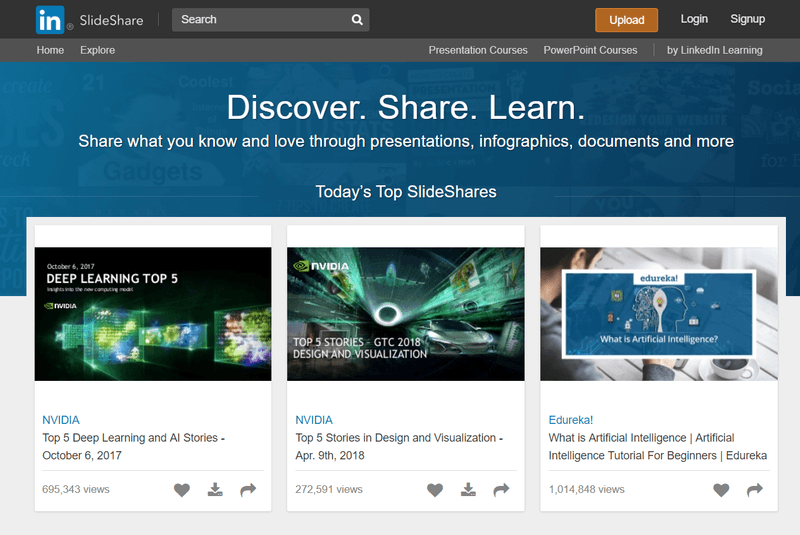In 2016, SlideShare had over 70 million unique visitors per day, and it was listed by Alexa as one of the top 100 most visited websites in the world. At its peak, it was such a powerhouse that Obama used the network to post his birth certificate. It also stood for years as a premier B2B social channel: In 2015, author and marketing expert Jay Baer referred to it as “content marketing’s secret weapon.”

Power users have been dropping the SlideShare channel.
-
Top content creator and SlideShare investor Dave McLure hasn’t posted to the channel in over 11 months.
-
HubSpot, the content marketing powerhouse that posted over 60 presentations in 2017 and reached over 500,000 users, has posted only once in 2018, reaching a total of just over 1,000 users.
-
So what has caused this exodus of power users and decline in social-media prominence? A perfect storm of shifting parent-company priorities, insufficient revenues, and a user base largely outside of the US.
Despite SlideShare’s massive fan base, loyal users, and billions of impressions, a once-powerful channel is all but dead, and here’s why.
The Loss of Human Touch
The rapid growth of SlideShare from a small startup to a top website began in 2009, in a tiny room in India, when Amit Rajan, Rashmi Sinha, and Jonathan Boutelle saw the need for a “YouTube for presentations.” Within a few years, they had built a network of 38 million registered users by providing a desperately needed tool—and a new social channel for presentations. But the key to their success wasn’t the tool, it was the human touch it added to the presentations.
SlideShare didn’t have a marketing team fueling its rapid growth. It relied on loyal fans. Its fans were the content creators, and to ensure the best content was featured, the team at SlideShare would manually curate the site each day, ensuring that the best presentations were prominently featured.
-
Kit Seeborg, author of Present Yourself: Using SlideShare to Grow Your Business, was responsible for most of the content curation the users loved, she stressed how important human curation was to SlideShare.
-
The curated content was a huge hit. It was also one of the drivers of SlideShare’s email list, which, at the time of LinkedIn’s acquisition of SlideShare in 2012, was growing by 250,000 new subscribers each week. After the sale to LinkedIn, the curation process remained a critical part of community-building, until 2016, when the program was ended. Since then, the homepage has changed very little, which was a major clue to marketing insiders that LinkedIn was giving up on SlideShare.
-
During 2016, the team of editors who had been curators for SlideShare were moved off the product to support other LinkedIn projects, such as Pulse. The SlideShare company page on LinkedIn is now blank, with only a few remaining engineers listed as employees.
Some alternatives to SlideShare:
-
Host your own content. There are new plugins for websites which allow you to host your slides on your own website and allow easy sharing and embedding.
-
Microsoft may create a social PowerPoint for 365. That is speculation, but now that LinkedIn is owned by Microsoft, and with the recent move to put Office in the Cloud, we could potentially see a new social aspect of PowerPoint in the future.
-
Use Prezi. It’s an alternative to SlideShare, but it does require you create content in Prezi’s own software rather than in PowerPoint; that requirement can be a pain for some.
-
Use Google or Dropbox or ISSUU document sharing with their built-in presentation handling.
As we are continually bombarded with new marketing channels, tactics, and tools, one thing is clear: Slides are not going away. Events seem to give brands the personal touch the digital world just can’t, and slides are usually the No.1 content type at events.
The “YouTube of presentations” was at one point the number one destination for business owners and managers. It sported better demographics and site visitor loyalty than even LinkedIn. It was one of the top 100 most visited websites on the planet. Maybe that’s why LinkedIn bought it for $119 million in 2012, padding the nest eggs of serial investors and Slideshare backers Mark Cuban and Dave McClure, among others.
The 3 Biggest Slideshare Problems Today
- First, traffic to Slideshare has fallen off considerably. This is despite the fact that three-quarters of all content marketers are creating more content than ever, according to the Content Marketing Institute and MarketingProfs. To be sure not all of that content is in the form of presentations and ebooks that are found on Slideshare.
- Second, Slideshare has jettisoned their editorial team, for the most part. At its apex, part of Slideshare’s appeal was its curation, including regular promotion of new and interesting presentations to the site’s home page in the “Today’s Top Slideshares,” “Featured Slideshares,” or “Trending in Social Media” sections.
- Third, Slideshare now appears to be making puzzlingly awful customer experience decisions. I have no idea if this is correlation or causation.
Slideshare’s coming passing comes on the heels of the death of Squidoo and Scribd, among others.